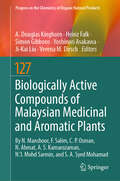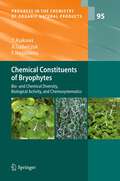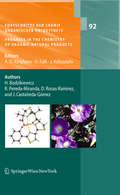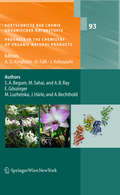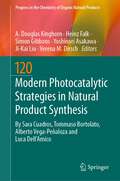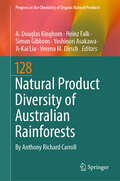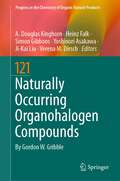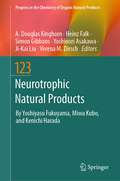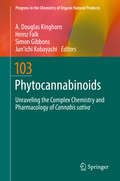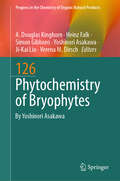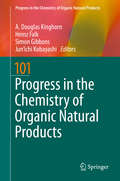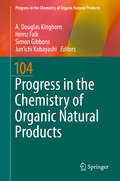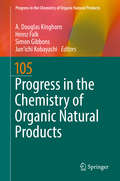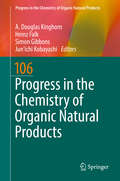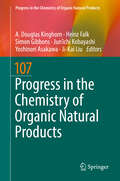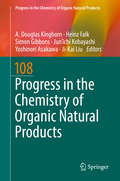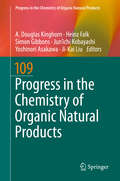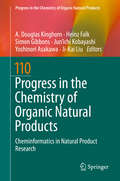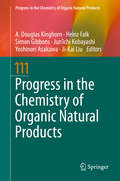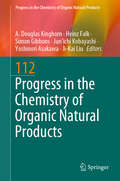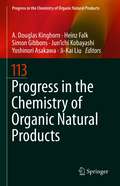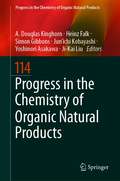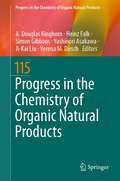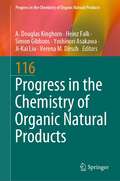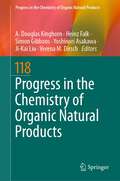- Table View
- List View
Biologically Active Compounds of Malaysian Medicinal and Aromatic Plants (Progress in the Chemistry of Organic Natural Products #127)
by A. Douglas Kinghorn Heinz Falk Simon Gibbons Yoshinori Asakawa Ji-Kai Liu Verena M. DirschThis volume explores the biologically active compounds found in 21 high-value medicinal and aromatic plant species native to Malaysia, emphasizing their phytochemical diversity and biological activities. Several of these plants, including Eurycoma longifolia, Andrographis paniculata, Morinda citrifolia, Centella asiatica, and Moringa pleifera, have been prioritized as high-priority herbal products under Malaysia's National Key Economic Area in the Eleventh Malaysia Plan. Their importance transcends traditional herbal medicine, as they are increasingly recognized for their potential contributions to the national economy and modern healthcare. The volume describes the pharmacological properties of these plants, highlighting their anti-inflammatory, antioxidant, antimicrobial, and cytotoxic activities. It also encompasses aromatic plants like Clinacanthus nutans, Cananga odorata, Citrus hystrix, and Polygonum minus, focusing on their bioactive compounds and potential therapeutic and industrial uses.
Chemical Constituents of Bryophytes: Bio- and Chemical Diversity, Biological Activity, and Chemosystematics (Progress in the Chemistry of Organic Natural Products #95)
by A. Douglas Kinghorn Heinz Falk Junichi Kobayashi Agnieszka Ludwiczuk Fumihiro Nagashima Yoshinori AsakawaFor some 50 years, Professor Asakawa and his group have focused their research on the chemical constituents of bryophytes and have found that these plants contain large numbers of secondary metabolites, such as terpenoids, acetogenins, and aromatic compounds representative of many new skeletons, which exhibit interesting biological activities. Individual terpenoids, when found as constituents of both a bryophyte and a higher plant, tend to occur in different enantiomeric forms. Professor Asakawa has covered the literature on bryophytes in two earlier volumes of Progress in the Chemistry of Organic Natural Products, namely, Volumes 42 (1982) and 65 (1995). Since the publication of the latter volume, a great deal of new information has appeared on bryophytes. One example is that known sex pheromones of algae have been discovered in two liverworts, indicating that some members of the latter taxonomic group might originate from brown algae. From information provided in this volume, it is suggested that two orders of the Marchantiophyta should be combined.
Fortschritte der Chemie organischer Naturstoffe / Progress in the Chemistry of Organic Natural Products, Vol. 92
by A. Douglas Kinghorn Herbert Budzikiewicz Heinz Falk Rogelio Pereda-Miranda Daniel Rosas-Ramírez Junichi Kobayashi Jhon Castañeda-GómezThe volumes of this classic series, now referred to simply as "Zechmeister" after its founder, L. Zechmeister, have appeared under the Springer Imprint ever since the series' inauguration in 1938. The volumes contain contributions on various topics related to the origin, distribution, chemistry, synthesis, biochemistry, function or use of various classes of naturally occurring substances ranging from small molecules to biopolymers. Each contribution is written by a recognized authority in his field and provides a comprehensive and up-to-date review of the topic in question. Addressed to biologists, technologists, and chemists alike, the series can be used by the expert as a source of information and literature citations and by the non-expert as a means of orientation in a rapidly developing discipline.
Fortschritte der Chemie organischer Naturstoffe / Progress in the Chemistry of Organic Natural Products, Vol. 93
by A. Douglas Kinghorn Heinz Falk Junichi Kobayashi Sajeli A. Begum Johannes Härle Marta Luzhetska Anil B. Ray Edda Gössinger Mahendra SahaiThe volumes of this classic series, now referred to simply as "Zechmeister" after its founder, L. Zechmeister, have appeared under the Springer Imprint ever since the series' inauguration in 1938. The volumes contain contributions on various topics related to the origin, distribution, chemistry, synthesis, biochemistry, function or use of various classes of naturally occurring substances ranging from small molecules to biopolymers. Each contribution is written by a recognized authority in his field and provides a comprehensive and up-to-date review of the topic in question. Addressed to biologists, technologists, and chemists alike, the series can be used by the expert as a source of information and literature citations and by the non-expert as a means of orientation in a rapidly developing discipline.
Modern Photocatalytic Strategies in Natural Product Synthesis (Progress in the Chemistry of Organic Natural Products #120)
by A. Douglas Kinghorn Heinz Falk Simon Gibbons Yoshinori Asakawa Ji-Kai Liu Verena M. DirschThis book presents recent reports of total syntheses involving a photocatalytic reaction as a key step in the methodology. Modern photocatalysis has proven its generality for the development and functionalization of native functionalities. To date, the field has found broad applications in diverse research areas, including the total synthesis of natural products. Among the selected examples presented in this book, it highlights how the photocatalytic process proceeds in a highly chemo-, regio-, and stereoselective manner, thereby allowing the rapid access to structurally complex architectures under light-driven conditions.
Natural Product Diversity of Australian Rainforests (Progress in the Chemistry of Organic Natural Products #128)
by A. Douglas Kinghorn Heinz Falk Simon Gibbons Yoshinori Asakawa Ji-Kai Liu Verena M. DirschThe book reviews the natural product chemistry of Australian rainforest plants, with a particular focus on their fascinating phylogenetic relationships. It discusses the unique flora of Australia, which is of Gondwanan origin, and how this has led to a diverse range of natural products. The text explores the chemical constituents of various plant groups, including those of gymnosperms, basal angiosperms, magnoliids, monocots, and eudicots, with an emphasis on the Australian rainforest species. Key points covered include the historical context of Australian flora, its high level of endemism, and the impact of past climatic changes on rainforest distribution. The book also details the specific phytochemicals found in these plants (about 2,400), such as alkaloids, lignans, and terpenoids, and their biological activities. Overall, this comprehensive volume highlights the importance of Australian rainforests as a rich source of unique natural products and emphasizes the need for further research in this area, in particular given that only approximately 10% of these rainforest species have been investigated so far.
Naturally Occurring Organohalogen Compounds (Progress in the Chemistry of Organic Natural Products #121)
by A. Douglas Kinghorn Heinz Falk Simon Gibbons Yoshinori Asakawa Ji-Kai Liu Verena M. DirschThe present volume is the third in a trilogy that documents naturally occurring organohalogen compounds, bringing the total number — from fewer than 25 in 1968 — to approximately 8,000 compounds to date. Nearly all of these natural products contain chlorine or bromine, with a few containing iodine and, fewer still, fluorine. Produced by ubiquitous marine (algae, sponges, corals, bryozoa, nudibranchs, fungi, bacteria) and terrestrial organisms (plants, fungi, bacteria, insects, higher animals) and universal abiotic processes (volcanos, forest fires, geothermal events), organohalogens pervade the global ecosystem. Newly identified extraterrestrial sources are also documented. In addition to chemical structures, biological activity, biohalogenation, biodegradation, natural function, and future outlook are presented.
Neurotrophic Natural Products (Progress in the Chemistry of Organic Natural Products #123)
by A. Douglas Kinghorn Heinz Falk Simon Gibbons Yoshinori Asakawa Ji-Kai Liu Verena M. DirschThis book deals with neurotrophins (NGF, BDNF, NT3, NT4), which can decrease cell death, induce differentiation, as well as sustain the structure and function of neurons. This makes neurotrophins potential therapeutic agents for the treatment of neurodegenerative disorders. However, these proteins have so far been ineffective in clinical trials mostly because they cannot pass the blood-brain barrier owing to their high-molecular weights. Consequently, small molecules that mimic neurotrophins and stimulate the synthesis of endogenous neurotrophins or enhance their neurotrophic actions are expected to be promising alternatives. Small-molecule natural products, which have been used in dietary functional foods or in traditional medicine over the course of human history, have potential to be developed as new therapeutic agents against neurodegenerative conditions such as Alzheimer’s disease. In this book, the authors introduce a variety of natural products possessing neurotrophic properties such as neurogenesis, neurite outgrowth promotion (neuritogenesis), and neuroprotection and focus on the chemistry and biology of several neurotrophic natural products.
Phytocannabinoids
by A. Douglas Kinghorn Heinz Falk Simon Gibbons Jun’ichi KobayashiThe book presents the current state of the art on phytocannnabinoid chemistry and pharmacology and will be of much use to those wishing to understand the current landscape of the exciting and intriguing phytocannabinoid science. The focus is on natural product cannabinoids which have been demonstrated to act at specific receptor targets in the CNS.
Phytochemistry of Bryophytes (Progress in the Chemistry of Organic Natural Products #126)
by A. Douglas Kinghorn Heinz Falk Simon Gibbons Yoshinori Asakawa Ji-Kai Liu Verena M. DirschThis book discusses the phytochemistry of bryophytes, with a particular focus on their biologically active natural products and their potential applications in medicine, cosmetics, and as foods. Bryophytes, which include the mosses, liverworts, and hornworts, produce a plethora of terpenoids, phenolic compounds, and polyketides that exhibit diverse pharmacological activities, including anti-inflammatory, antiobesity, antioxidant, cytotoxic, and muscle-relaxant effects. The volume also explores the characteristic odors and flavors of bryophytes, as well as their possible use in the cosmetics industry, as food additives, and ultimately as medicinal drugs. Additionally, the biosynthesis pathways and synthesis of selected bioactive bryophyte compounds are discussed, highlighting the potential of these fascinating and ancient plants as a source of novel and valuable natural products.
Progress in the Chemistry of Organic Natural Products 101
by A. Douglas Kinghorn Heinz Falk Simon Gibbons Jun'Ichi KobayashiThe volumes of this classic series, now referred to simply as "Zechmeister" after its founder, Laszlo Zechmeister, have appeared under the Springer Imprint ever since the series' inauguration in 1938. The series has featured contributions by seven Nobel laureates: D. H. R. Barton, D. Crowfoot Hodgkin, L. Pauling, K. Alder, O. Diels, P. Karrer, and H. von Euler-Chelpin. The volumes contain contributions on various topics related to the origin, distribution, chemistry, synthesis, biochemistry, function or use of various classes of naturally occurring substances ranging from small molecules to biopolymers. Each contribution is written by a recognized authority in the field and provides a comprehensive and up-to-date review of the topic in question. Addressed to biologists, technologists, and chemists alike, the series can be used by the expert as a source of information and literature citations and by the non-expert as a means of orientation in a rapidly developing discipline.
Progress in the Chemistry of Organic Natural Products 104 (Progress in the Chemistry of Organic Natural Products #104)
by A. Douglas Kinghorn Heinz Falk Simon Gibbons Jun'Ichi KobayashiThe first contribution describes apolar and polar molecular fossils and, in particular biomarkers, along the lines usually followed in organic chemistry textbooks, and points to their bioprecursors when available. Thus, the apolar compounds are divided in linear and branched alkanes followed by alicyclic compounds and aromatic and heterocyclic molecules, and, in particular, the geoporphyrins. The polar molecular fossils contain as functional groups or constituent units ethers, alcohols, phenols, carbonyl groups, flavonoids, quinones, and acids, or are polymers like kerogen, amber, melanin, proteins, or nucleic acids. The final sections discuss the methodology used and the fundamental processes encountered by the biomolecules described, including diagenesis, catagenesis, and metagenesis. The second contribution covers the distribution of phthalides in nature and the findings in the structural diversity, chemical reactivity, biotransformations, syntheses, and bioactivity of natural and semisynthetic phthalides.
Progress in the Chemistry of Organic Natural Products 105
by A. Douglas Kinghorn Heinz Falk Simon Gibbons Jun'Ichi KobayashiThe first contribution reviews the occurrence of xanthine alkaloids in the plant kingdom and the elucidation of the caffeine biosynthesis pathway, providing details of the N-methyltransferases, belonging to the motif B' methyltransferase family which catalyze three steps in the four step pathway leading from xanthosine to caffeine. The second contribution in this book provides a background on the molecule and related compounds and update knowledge on the most recent advances in Iboga alkaloids. The third contribution presents a comprehensive analysis of frequently occurring errors with respect to 13C NMR spectroscopic data and proposes a straightforward protocol to eliminate a high percentage of the most obvious errors.
Progress in the Chemistry of Organic Natural Products 106
by A. Douglas Kinghorn Heinz Falk Simon Gibbons Jun'Ichi KobayashiThe first contribution presents coumarins, the largest group of 1-benzopyran derivatives found in plants. Coumarin chemistry remains one of the major interest areas of phytochemists, especially because of their structural diversity and medicinal properties, along with the wide-ranging bioactivities of these compounds, inclusive of analgesic, anticoagulant anti-HIV, anti-inflammatory, antimicrobial, antineoplastic, antioxidant, and immunomodulatory effects. The second contribution presents a comprehensive survey of the many aspects of PAD biochemistry and physiology. The third contribution gives a comprehensive overview of secondary metabolites from higher fungi, with more than 700 references highlighting the isolation, structure elucidation, biological activities, chemical synthesis, and biosynthesis of pigments, nitrogen-containing compounds, and terpenoids from mushrooms.
Progress in the Chemistry of Organic Natural Products 107 (Progress in the Chemistry of Organic Natural Products #107)
by A. Douglas Kinghorn Heinz Falk Simon Gibbons Jun'Ichi Kobayashi Yoshinori Asakawa Ji-Kai LiuThe first review describes examples of very promising compounds discovered from plants acquired from Africa, Southeast Asia, the Americas, and the Caribbean region with potential anticancer activity. These include plant secondary metabolites of the diphyllin lignan, penta[b]benzofuran, triterpenoid, and tropane alkaloid types. The second review presents 40 more erythrinan alkaloids, which were either new or were missed out in the last major reviews, bringing to a total of 154 known erythrinan alkaloids known to date. The reported pharmacological activities of the new and known alkaloids showed a greater bias towards central nervous system and related activities. Other prominent activities reported were antifeedant or insecticidal, cytotoxicity/antitumor/anticancer/estrogenic, antiprotozoal, antiinflammatory, antioxidant, antifungal and antiviral activities.
Progress in the Chemistry of Organic Natural Products 108 (Progress in the Chemistry of Organic Natural Products #108)
by A. Douglas Kinghorn Heinz Falk Simon Gibbons Jun'Ichi Kobayashi Yoshinori Asakawa Ji-Kai LiuThe first contribution summarizes current trends in research on medicinal plants in Mexico with emphasis on work carried out at the authors' laboratories. The most relevant phytochemical and pharmacological profiles of a selected group of plants used widely for treating major national health problems are described. The second contribution provides a detailed survey of the so far reported literature data on the capacities of selected oxyprenylated phenylpropanoids and polyketides to trigger receptors, enzymes, and other types of cellular factors for which they exhibit a high degree of affinity and therefore evoke specifice responses. And the third contribution discusses aspects of endophytic actinobacterial biology and chemistry, including biosynthesis and total synthesis of secondary metabolites produced in culture. It also presents perspectives fo the future of microbial biodiscovery, with emphasis on the seondary metabolism of endophytic actinobacteria.
Progress in the Chemistry of Organic Natural Products 109 (Progress in the Chemistry of Organic Natural Products #109)
by A. Douglas Kinghorn Heinz Falk Simon Gibbons Yoshinori Asakawa Jun’ichi Kobayashi Ji-Kai LiuThis volume comprises three reviews. The first describes isolation, structure determination, syntheses, and biochemistry of the low molecular weight compounds of the secretion of exocrine glands of termies with emphasis to pheromones and defensive compounds. The second review describes recent studies on isolation and structure elucidation of bioactive compounds involved in the life cycle and determination of the molecular mechanisms of the developmental events observed in higher plants. The third contribution reports on the current body of knowledge of African propolis, with a particular emphasis on its chemistry and biological activity.
Progress in the Chemistry of Organic Natural Products 110: Cheminformatics in Natural Product Research (Progress in the Chemistry of Organic Natural Products #110)
by A. Douglas Kinghorn Heinz Falk Simon Gibbons Yoshinori Asakawa Jun’ichi Kobayashi Ji-Kai LiuThe book summarizes important aspects of cheminformatics that are relevant for natural product research. It highlights cheminformatics tools that help to match natural products with their respective biological targets or off-targets, and discusses the potential and limitations of this approach.
Progress in the Chemistry of Organic Natural Products 111 (Progress in the Chemistry of Organic Natural Products #111)
by A. Douglas Kinghorn Heinz Falk Simon Gibbons Yoshinori Asakawa Jun’ichi Kobayashi Ji-Kai LiuThe first chapter in volume 111 summarizes research on the sesterterpenoids, which are known as a relatively small group of natural products. However, they express a variety of simple to complicated chemical structures. This chapter focuses on the chemical structures of sesterterpenoids and how their structures are synthesized in Nature. The second chapter is devoted to marine-derived fungi, which play an important role in the search for structurally unique secondary metabolites, some of which show promising pharmacological activities that make them useful leads for drug discovery. Marine natural product research in China in general has made enormous progress in the last two decades as described in this chapter on fungal metabolites. This contribution covers 613 new natural products reported from 2001 to 2017 from marine-derived fungi obtained from algae, sponges, corals, and other marine organisms from Chinese waters.
Progress in the Chemistry of Organic Natural Products 112 (Progress in the Chemistry of Organic Natural Products #112)
by A. Douglas Kinghorn Heinz Falk Simon Gibbons Yoshinori Asakawa Jun’ichi Kobayashi Ji-Kai LiuThe first chapter describes the oldest method of communication between living systems in Nature, the chemical language. Plants, due to their lack of mobility, have developed the most sophisticated way of chemical communication. Despite that many examples involve this chemical communication process - allelopathy, there is still a lack of information about specific allelochemicals released into the environment, their purpose, as well as in-depth studies on the chemistry underground. These findings are critical to gain a better understanding of the role of these compounds and open up a wide range of possibilities and applications, especially in agriculture and phytomedicine. The most relevant aspects regarding the chemical language of plants, namely, kind of allelochemicals have been investigated, as well as their releasing mechanisms and their purpose, are described in this chapter. The second chapter is focused on the natural products obtained from Hypericum L., a genus of the family Hypericaceae within the dicotyledones. Hypericum has been valued for its important biological and chemical properties and its use in the treatment of depression and as an antibacterial has been well documented in primary literature and ethnobotanical reports. The present contribution gives a comprehensive summary of the chemical constituents and biological effects of this genus. A comprehensive account of the chemical constituents including phloroglucinol derivatives, xanthones, dianthrones, and flavonoids is included. These compounds show a diverse range of biological activities that include antimicrobial, cytotoxic, antidepressant-like, and antinociceptive effects. The third chapter addresses microtubule stabilizers, which are a mainstay in the treatment of many solid cancers and are often used in combination with molecularly targeted anticancer agents and immunotherapeutics. The taccalonolides are a unique class of such microtubule stabilizers isolated from plants of Tacca species that circumvent clinically relevant mechanisms of drug resistance. Although initial reports suggested that the microtubule stabilizing activity of the taccalonolides is independent of direct tubulin binding, additional studies have found that potent C-22,23 epoxidated taccalonolides covalently bind the Aspartate 226 residue of β-tubulin and that this interaction is critical for their microtubule stabilizing activity. Some taccalonolides have demonstrated in vivo antitumor efficacy in drug-resistant tumor models with exquisite potency and long-lasting antitumor efficacy as a result of their irreversible target engagement. The recent identification of a site on the taccalonolide scaffold that is amenable to modification has provided evidence of the specificity of the taccalonolide-tubulin interaction and the opportunity to further optimize the targeted delivery of the taccalonolides to further improve their anticancer efficacy and potential for clinical development.
Progress in the Chemistry of Organic Natural Products 113 (Progress in the Chemistry of Organic Natural Products #113)
by A. Douglas Kinghorn Heinz Falk Simon Gibbons Yoshinori Asakawa Jun’ichi Kobayashi Ji-Kai LiuIn this book, chemical studies are described mainly from literature reports appearing since 2000, inclusive of investigations performed by the present authors, on the diversity in secondary metabolites of Ligularia growing in the Hengduan Mountains area of China, focusing on eremophilane sesquiterpenoids and other metabolites. More than 100 Ligularia species and their related genera in the plant family Senecioneae plants (Cremanthodium, Cacalia, Senecio, and others) grow in East Asia. For many years, researchers have studied the chemical constituents of these plants, and terpenoids, flavonoids, steroids, alkaloids, and aromatic compounds have been isolated. Among these, in particular, numerous sesquiterpenoids were reported. Within this book terpenoids and aromatic compounds (total 1049), both previously unknown and known, are presented. Finally, genetic studies and synthesis investigations are briefly reviewed.
Progress in the Chemistry of Organic Natural Products 114 (Progress in the Chemistry of Organic Natural Products #114)
by A. Douglas Kinghorn Heinz Falk Simon Gibbons Yoshinori Asakawa Jun’ichi Kobayashi Ji-Kai LiuThis book describes current understandings and recent progress in four areas: in the first one, the cytochalasans, a group of fungal derived natural products characterized by a perhydro-isoindolone core fused with a macrocyclic ring are shown to exhibit high structural diversity and a broad spectrum of bioactivities. The second one is dedicated to a description of bioactive compounds from the medicinal plants of Myanmar, the third one is dedicated to new structure elucidation techniques in the field of sesquiterpenes. The last one discusses the endogenous natural products that are produced by human cells including endogenous amines, steroids, and fatty acid derived natural products. The co-metabolism and natural product production of the human microbiome is also described including tryptophan, bile acids, choline, and cysteine.
Progress in the Chemistry of Organic Natural Products 115 (Progress in the Chemistry of Organic Natural Products #115)
by A. Douglas Kinghorn Heinz Falk Simon Gibbons Yoshinori Asakawa Ji-Kai Liu Verena M. DirschThis book describes current understandings and recent progress into a varied group of natural products. In the first chapter the role that total synthesis may play in revising the structures proposed for decanolides, which are ten-membered lactones found primarily in fungi, frogs, and termites is presented. The following chapter presents the development of the intriguing plant-derived sesquiterpene lactone, thapsigargin, a potent inhibitor of the enzyme, SERCA (sarco-endoplasmic Ca2+ ATPase), which has potential as a lead compound to treat cancer. The third chapter covers the potential of various plant phenolic compounds for treating the tropical and sub-tropical infectious disease, leishmaniasis. In addition the volume presents recent advances related to the plant alkaloid, cryptolepine, which is of particular interest as a lead for the treatment of malaria, trypanosomiasis, and cancer.
Progress in the Chemistry of Organic Natural Products 116 (Progress in the Chemistry of Organic Natural Products #116)
by A. Douglas Kinghorn Heinz Falk Simon Gibbons Yoshinori Asakawa Ji-Kai Liu Verena M. DirschThis volume describes several highly diverse subjects: Chapter 1 explores marine biodiscovery of the North-eastern Atlantic off the coast of Ireland as a model for best practice in research. The second chapter investigates Brazilian Chemical Ecology and examples of insect-plant communication studies that are mediated by natural products demonstrate the beautiful interconnectedness of species in a biome. Our third chapter comprises the advances in the science of the sesquiterpene quinone, perezone, which in 1852 was the first natural product isolated in crystalline form in the New World. The last two chapters are from a Vietnamese group and the first of these follows the phytochemistry, pharmacology, and ethnomedical uses of the genus Xanthium, which produces interesting sulfur and nitrogen containing natural products. Finally, the genus Desmos is discussed, where an overview of its constituent natural products and their in vitro pharmacological potential is described.
Progress in the Chemistry of Organic Natural Products 118 (Progress in the Chemistry of Organic Natural Products #118)
by A. Douglas Kinghorn Heinz Falk Simon Gibbons Yoshinori Asakawa Ji-Kai Liu Verena M. DirschThis volume consists of four chapters that cover a structurally diverse range of naturally occurring compounds. Chapter 1 delves into the chemistry of pyrogallols and their oxidized products, the hydroxy-o-quinones, including their role in cycloaddition reactions in the chemical synthesis of several fungal metabolites. Chapter 2 provides an in-depth description of the constituents of agarwood essential oil and smoke samples that are used in the perfumery industry, with an emphasis on the sesquiterpenoid and chromones constituents so far known. Chapter 3 discusses the defensive chemical ecology of two North American newt species that both produce tetrodotoxin, a well-known neurotoxin that causes paralysis and death in metazoans by disrupting electrical signals in the nerves and muscles. Chapter 4 discusses the limonoids and triterpenoids from the genus Walsura of the plant family Meliaceae, of which a number of species are utilized in several southeastern Asian countries in systems of folk medicine.
